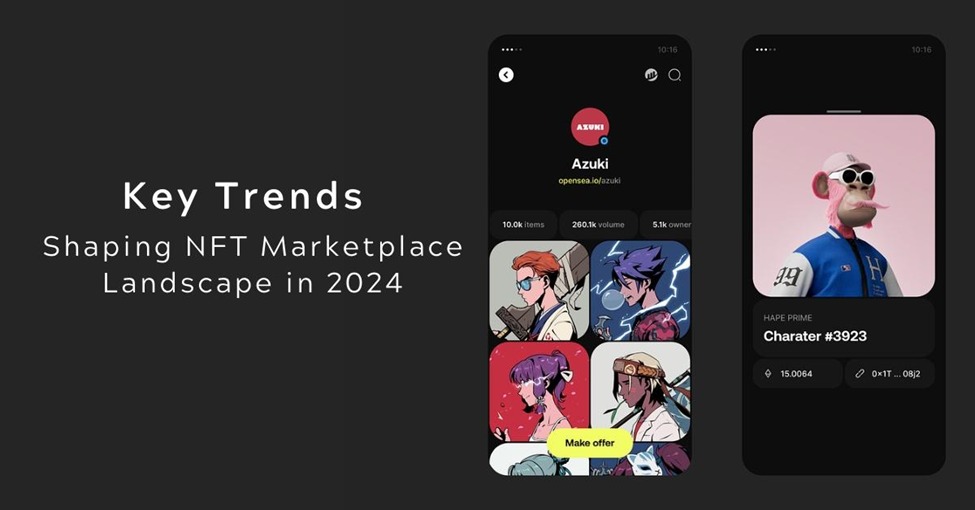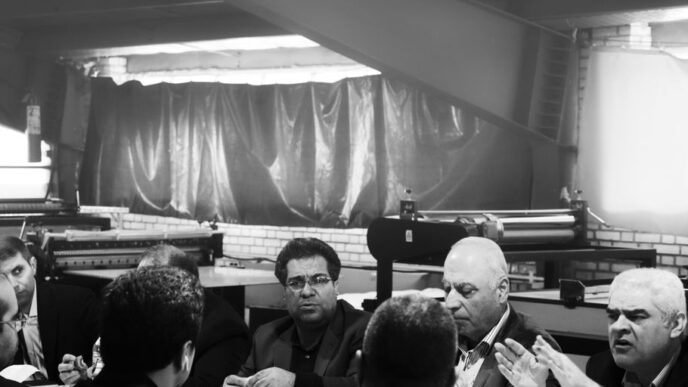NFT marketplaces, irrespective of scratch or White-label, consistently gained significant attention from businesses and investors, serving as lucrative platforms for revenue generation and establishing a prominent brand presence within the industry. This blog explores vital insights and emerging trends with its overview and real-time examples that demand attention in the NFT market as we approach 2024.
The Evolution of NFT Development Trends Shaping 2024
As we conclude 2023, numerous sectors and brands are venturing into the NFT landscape, fostering high expectations for the sustained growth of existing trends and the emergence of new dynamics shaping NFT marketplaces.
Collaborate with a leading NFT marketplace development company to seamlessly integrate these trends.
Below, we highlight some promising trends and sectors set to impact 2024.
PFP NFTs
PFP NFTs, a distinctive type of non-transferable token, are uniquely tied to a person’s online profile image or avatar, commonly employed on social networks and virtual communities for self-expression. Unlike regular NFTs, PFP NFTs prioritize personal branding in the digital realm.
Ownership of these tokens empowers individuals to:
- Showcase support for specific artists or projects.
- Express their individuality.
- Participate in exclusive events associated with the project.
While PFP NFTs are still integrating into daily life, Twitter Plus users already enjoy the ability to update their profile avatars using this technology. Positioned as the next trend in NFT development for 2024, PFP NFTs are shaping the digital identity landscape, making them a noteworthy focus.
As Bitcoin (BTC) surpasses the $40,000 mark, interest in BTC-based NFTs has intensified. The rise is accompanied by a surge in trading volumes for Bitcoin Ordinals, reaching $15.94 million on December 3, a 200% increase from the recent low on November 26th. SVARGA, a novel experiment on Bitcoin Ordinals, has garnered attention for transforming traditional PFP NFTs into interactive avatars. SVARGA utilizes a unique approach, gathering metadata to create full-body images that undergo Spine skeletal animation, enhancing visual appeal and interactivity.
Fractional NFTs
Fractional NFTs subdivided tokens to broaden user participation and facilitate fund redistribution across various assets, drawing inspiration from real-world shared ownership models in real estate, family subscriptions, and company stocks. Positioned as a pivotal trend in NFT development for 2024, the innovative concept seeks to revolutionize ownership and value distribution in the NFT landscape.
As a real-time example, Ommniverse, an inventive platform, strives to simplify fractional NFT ownership, catering to a broader audience. By reshaping perspectives on the value of NFT fractions, it aims to establish itself as a leading name in the NFT community. With enticing incentives for holders and creators, it is poised to become the preferred platform for secure fractional NFT ownership solutions, providing a cost-effective way for investors to incorporate NFT art into their digital portfolios.
NFT Memberships
Like traditional event or brand memberships in Web2, NFT memberships offer additional advantages for organizers and fans. The rising popularity of NFT memberships can be attributed to several key factors:
Counterfeiting Prevention: They eliminate the risk of counterfeiting, unlike traditional cards that can be easily copied or stolen as they are secured by blockchains.
Enhanced User Experience: Brands leveraging NFT-based memberships provide the ultimate user experience, offering online and offline services. These include exclusive event access, behind-the-scenes content, limited releases of physical goods, and even voting rights.
Versatile Formats: Similar to traditional affiliate programs, NFT memberships come in diverse formats, making them a pivotal trend in NFT development for 2024. Ownership of an NFT, for instance, could grant access to exclusive online communities like the Bored Ape Yacht Club or confer voting rights in a DAO such as LinksDAO.
NFT Gaming
Non-fungible tokens (NFTs) have profoundly influenced the gaming industry by introducing a revolutionary method to convey ownership and scarcity of in-game assets. In the realm of NFT gaming, distinctive and indivisible tokens are employed to symbolize digital items within video games. Diverging from conventional in-game items, NFTs find their home on blockchain networks, affording players genuine ownership and the freedom to trade or sell their virtual assets.
In 2020, “fungible” and “NFT” emerged as notable words, with NFTs gaining immense popularity, recording over $40 billion in transactions on Ethereum in 2021. However, the NFT market experienced a significant crash in 2022, leading to a 97% drop in volume and a broader crypto industry decline of around $2 trillion. Despite the downturn, Pudgy Penguins, a distinct NFT project, stood resilient, announcing the launch of a physical toy line in 2023 and unveiling plans for an immersive digital world, Pudgy World, in 2024. The project successfully navigated challenges and innovations, culminating in a remarkable year.
AI-Based NFTs
AI-generated NFTs represent unique tokens crafted through artificial intelligence, offering vast possibilities for artists, musicians, and content creators within the blockchain landscape.
Beyond the creation of NFTs, this niche presents opportunities in the following facets:
Authentication: AI algorithms analyze blockchain data linked to NFTs, detecting and preventing the sale of fraudulent tokens.
Prediction and Analysis: Leveraging AI, one can forecast NFT values based on historical sales data, market trends, and social media sentiment.
In the landscape of 2024 NFT trends, the integration of artificial intelligence into blockchain not only attracts new users but also enhances the overall capabilities of the sector.
Once known for file-sharing, LimeWire has transformed into an AI-powered content publishing platform, leveraging blockchain technology. Under new ownership by brothers Julian and Paul Zehetmayr, LimeWire’s AI Music Studio enables users to create AI-generated tunes minted on either Polygon or Algorand blockchains. The platform allows content ownership and tradeability through blockchain, facilitating creators to monetize via an ad-revenue share program. Having raised $10 million in April 2022, LimeWire aims to lower barriers to NFT entry with its music-focused digital collectibles marketplace.
Layer-2 NFT solutions
Layer-2 NFT solutions address the challenges posed by the Ethereum network’s congestion, which experienced the deployment of 28.9 thousand NFT collections in 2022. This popularity strained the network, causing increased transaction costs and delays.
These solutions, built atop Layer-1, enhance blockchain scalability by processing transactions off-chain, ensuring security, decentralization, and integrity while reducing gas costs. Notable Layer-2 types include zero-knowledge (ZK) rollups, optimistic rollups, plasma, and sidechains. As the market evolves, exploring the most popular Layer-2 NFT solutions offers insights into the trends shaping 2024.
For example, PayPal is actively exploring various domains within the cryptocurrency ecosystem, as evidenced by recent patent applications. One of its applications, unveiled in March 2022, focuses on the selection process for blockchain validators/miners, allowing steering of requests to specific subsets. Additional patents delve into off-chain transactions through NFT marketplaces, introducing seamless transactions for digital assets.
Carbon Credit NFTs
Carbon credit NFTs represent a novel approach to achieving environmental sustainability within the blockchain space. These non-fungible tokens (NFTs) are unique digital assets that verify offsetting carbon emissions. By retiring traditional carbon credits as NFTs on blockchain networks, such as Ethereum or Solana, these tokens provide a transparent and traceable way to demonstrate environmental impact mitigation. Companies and individuals can engage with carbon credit NFTs to support and showcase their commitment to carbon neutrality, contributing to a greener and more sustainable future.
Solana, a leading Proof-of-Stake blockchain known for sustainability, has raised the bar by offsetting 100% of its 2022 carbon footprint directly on the blockchain, detailed in the December 2023 Energy Use Report. Partnering with ecoToken and Sunrise Stake, they retired 10,000+ tons of carbon credits as NFTs on the Solana network. Despite a recent decline after the FTX crash, SOL has shown resilience, rising over 5% recently. With ongoing carbon-neutral efforts, Solana may attract increased confidence from investors, and carbon credit NFTs are a significant trend to focus on in 2024.
Wrapping Up
You can ensure the sustainability of your project by incorporating the trends mentioned above into your NFT marketplace. You can consider leveraging White-label solutions from reputable providers and strategizing your market entry with an NFT marketplace that aligns with the top trends in the NFT sector for 2024, offering valuable insights for a successful venture.











